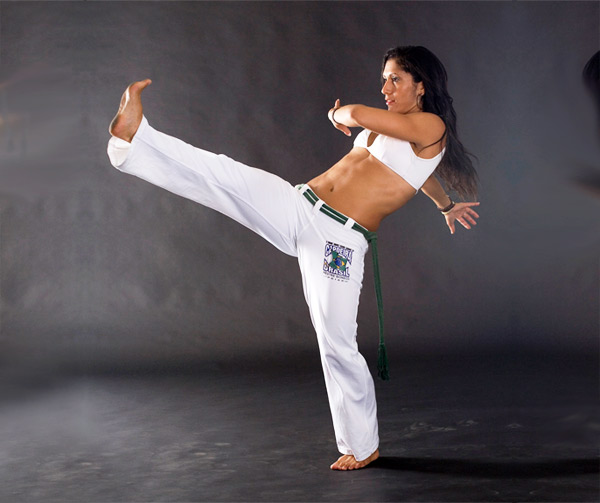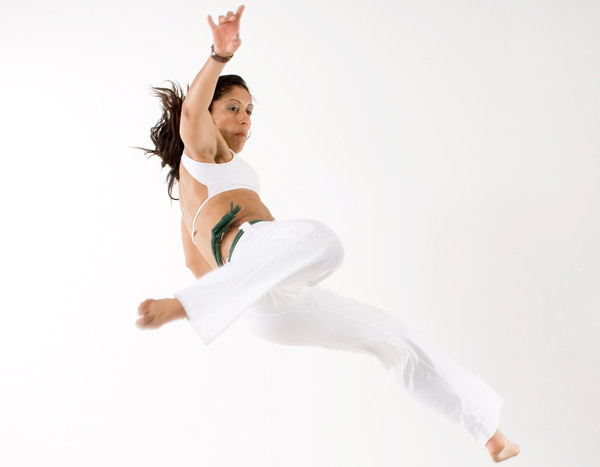
Capoeira is a Brazilian martial art that combines elements of dance, acrobatics and music, and is sometimes referred to as a game. It was developed in Brazil mainly by West African descendants with native Brazilian influences, probably beginning in the 16th century. It is known for quick and complex moves, using mainly power, speed, and leverage for a wide variety of kicks, spins, and highly mobile techniques.
The most widely accepted origin of the word capoeira comes from the Tupi words ka’a (“jungle”) e pûer (“it was”), referring to the areas of low vegetation in the Brazilian interior where fugitive slaves would hide. Practitioners of the art are called capoeiristas. On 26 November 2014 capoeira was granted a special protected status as “intangible cultural heritage” by UNESCO.
Capoeira’s history begins with the beginning of African slavery in Brazil. Since the 17th century, Portuguese colonists began exporting slaves to their colonies, coming mainly from West Africa. Brazil, with its vast territory, received most of the slaves, almost 40% of all slaves sent through the Atlantic Ocean.
The early history of capoeira is still controversial, especially the period between the 16th century and the beginning of the 19th century, since historical documents were very scarce in Brazil at that time. But oral tradition and evidence leaves little doubt about its African roots. Each group tends to have their own specific views on the history of capoeira.
Those such as Abada and Cordao de Ouro view the art form as a Brazilian art form while certain “angoleiros” such as Mestre Moraes, view the art as purely African. Other groups, such as Senzala de Santos, view the art form as a combination of not only African and Brazilian, but Native American too.
Capoeira nowadays is not only a martial art, but an active exporter of Brazilian culture all over the world. Since the 1970s, capoeira mestres began to emigrate and teach it in other countries. Present in many countries on every continent, every year capoeira attracts to Brazil thousands of foreign students and tourists. Foreign capoeiristas work hard to learn Portuguese to better understand and become part of the art. Renowned capoeira mestres often teach abroad and establish their own schools. Capoeira presentations,
normally theatrical, acrobatic and with little martiality, are common sights around the world.
The martial art aspect is still present and still disguised, leading many non-practitioners to ignore its presence. Trickery is ever present and expert capoeiristas can even disguise an attack as a friendly gesture.
Symbol of the Brazilian culture, symbol of the ethnic amalgam that characterizes Brazil, symbol of resistance to the oppression, capoeira definitely changed its image and became a source of pride to Brazilian people. Capoeira is officially considered intangible cultural heritage of Brazil.
Capoeira is a fast and versatile martial art which is historically focused on fighting outnumbered or in technological disadvantage. The style emphasizes using the lower body to kick, sweep and take down and the upper body to assist those movements and occasionally attack as well. It features a series of complex positions and body postures which are meant to get chained in an uninterrupted flow, in order to strike, dodge and move without breaking motion, conferring the style with a characteristic unpredictability and versatility.
The ginga (literally: rocking back and forth; to swing) is the fundamental movement in capoeira, important both for attack and defense purposes. It has two main objectives. One is to keep the capoeirista in a state of constant motion, preventing him or her from being a still and easy target. The other, using also fakes and feints, is to mislead, fool, trick the opponent, leaving them open for an attack or a counter-attack.
The attacks in the capoeira should be done when opportunity arises, and though can be preceded by feints or pokes, they must be precise and decisive, like a direct kick to the head, face or a vital body part, or a strong takedown. Most capoeira attacks are made with the legs, like direct or swirling kicks, rasteiras (leg sweeps), tesouras or knee strikes. Elbow strikes, punches and other forms of takedowns complete the main list. The head strike is a very important counter-attack move.
The defense is based on the principle of non-resistance, meaning avoiding an attack using evasive moves instead of blocking it. Avoids are called esquivas, which depend on the direction of the attack and intention of the defender, and can be done standing or with a hand leaning on the floor. A block should only be made when the esquiva is completely non-viable. This fighting strategy allows quick and unpredictable counterattacks, the ability to focus on more than one adversary and to face empty-handed an armed adversary.
A series of rolls and acrobatics (like the cartwheels called aú or the transitional position called negativa) allows the capoeirista to quickly overcome a takedown or a loss of balance, and to position themselves around the aggressor in order to lay up for an attack. It is this combination of attacks, defense and mobility which gives capoeira its perceived ‘fluidity’ and choreography-like style.
As a game
Capoeiristas outside
Playing capoeira is both a game and a method of practicing the application of capoeira movements in simulated combat. It can be played anywhere, but it’s usually done in a roda. During the game most capoeira moves are used, but capoeiristas usually avoid using punches or elbow strikes unless it’s a very aggressive game.
The game usually does not focus on knocking down or destroying the opponent, rather it emphasizes skill. Capoeiristas often prefer to rely on a takedown like a rasteira, then allowing the opponent to recover and get back into the game. It is also very common to slow down a kick inches before hitting the target, so a capoeirista can enforce superiority without the need of injuring the opponent. If an opponent clearly cannot dodge an attack, there is no reason to complete it. However, between two high-skilled capoeiristas, the game can get much more aggressive and dangerous. Capoeiristas tend to avoid showing this kind of game in presentations or to the general public.
Videos
Roda
Capoeiristas in a roda (Porto Alegre, Brazil)
The Roda is a circle formed by capoeiristas and capoeira musical instruments, where every participant sings the typical songs and claps their hands following the music. Two capoeiristas enter the roda and play the game according to the style required by the musical instruments rhythm. The game finishes when one of the musicians holding a berimbau determine it, when one of the capoeiristas decide to leave or call the end of the game or when another capoeirista interrupts the game to start playing, either with one of the current players or with another capoeirista.
In a roda every cultural aspect of capoeira is present, not only the martial side. Aerial acrobatics are common in a presentation roda, while not seen as often in a more serious one. Takedowns, on the other hand, are common in a serious roda but rarely seen in presentations.
Batizado
The batizado is a ceremonial roda where new students will get recognized as capoeiristas and earn their first graduation. Also more experienced students may go up in rank, depending on their skills and capoeira culture. In Mestre Bimba’s Capoeira Regional, batizado was the first time a new student would play capoeira following the sound of the berimbau.
Students enter the roda against a high-ranked capoeirista (such as a teacher or master) and normally the game ends with the student being taken down. In some cases the more experienced capoeirista can judge the takedown unnecessary. Following the batizado the new graduation, generally in the form of a cord, is given.
Apelido
Traditionally, the batizado is the moment when the new practitioner gets or formalizes his or her apelido (nickname). This tradition was created back when capoeira practice was considered a crime. To avoid having problems with the law, capoeiristas would present themselves in the capoeira community only by their nicknames. So if a capoeirista was captured by the police, he would be unable to identify his fellow capoeiristas, even when tortured.
Apelidos can come from many different things. A physical characteristic (like being tall or big), a habit (like smiling or drinking too much), place of birth, a particular skill, an animal, or trivial things.
Even though apelidos or these nicknames are not necessary anymore, the tradition is still very alive not only in capoeira but in many aspects of Brazilian culture.
Chamada
Chamada means ‘call’ and can happen at any time during a roda where the rhythm angola is being played. It happens when one player, usually the more advanced one, calls his or her opponent to a dance-like ritual. The opponent then approaches the caller and meets him or her to walk side by side. After it both resume normal play.
While it may seem like a break time or a dance, the chamada is actually both a trap and a test, as the caller is just watching to see if the opponent will let his guard down so she can perform a takedown or a strike. It is a critical situation, because both players are vulnerable due to the close proximity and potential for a surprise attack. It’s also a tool for experienced practitioners and masters of the art to test a student’s awareness and demonstrate when the student left herself open to attack.
The use of the chamada can result in a highly developed sense of awareness and helps practitioners learn the subtleties of anticipating another person’s hidden intentions. The chamada can be very simple, consisting solely of the basic elements, or the ritual can be quite elaborate including a competitive dialogue of trickery, or even theatric embellishments.
Volta ao mundo
Volta ao mundo means around the world.
The volta ao mundo takes place after an exchange of movements has reached a conclusion, or after there has been a disruption in the harmony of the game. In either of these situations, one player will begin walking around the perimeter of the circle counter-clockwise, and the other player will join the volta ao mundo in the opposite part of the roda, before returning to the normal game.
Malandragem and Mandinga
Malandragem is a word that comes from malandro, which means a person who possesses cunning as well as malícia (malice). This, however, is misleading as the meaning of malicia in capoeira is the capacity to understand someone’s intentions. In Brazil men who used street smarts to make a living were called malandros. Later the meaning expanded, indicating a person who is a quick thinker in finding a solution for a problem.
In capoeira, malandragem is the ability to quickly understand an opponent’s aggressive intentions, and during a fight or a game, fool, trick and deceive him.
Similarly capoeiristas use the concept of mandinga. Mandinga can be translated “magic” or “spell”, but in capoeira a mandingueiro is a clever fighter, able to trick the opponent. Mandinga is a tricky and strategic quality of the game, and even a certain esthetic, where the game is expressive and at times theatrical, particularly in the Angola style. The roots of the term mandingueiro would be a person who had the magic ability to avoid harm due to protection from the Orixás.
Alternately Mandinga is a way of saying Mandinka (as in the Mandinka Nation) who are known as “musical hunters”. Which directly ties into the term “vadiação”. Vadiação is the musical wanderer (with flute in hand), traveler, vagabond.
Capoeira is currently being used as a tool in sports development (the use of sport to create positive social change) to promote psychosocial wellbeing in various youth projects around the world. Capoeira4Refugees is a UK-based NGO working with youth in conflict zones in the Middle East. Capoeira for Peace is a project based in the Democratic Republic of Congo. The Nukanti Foundation works with street children in Colombia.
Videos

